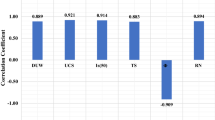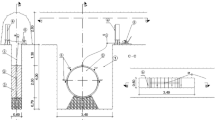Summary
Rock behavior, such as the stability of underground openings, is controlled by many different factors which have varying levels of influence. It is very difficult to identify the relative effect of each factor with traditional methods, such as structural analysis and statistical approaches. This paper introduces a hierarchical analytical method based on the application of neural networks which reveals the different degrees of importance of these factors so as to recognize the key factors. This makes it possible to focus on the key factors and do rock engineering more efficiently. An example is given applying this approach to an underground opening.
Similar content being viewed by others
References
Baba, N. (1994): A hybrid algorithm for finding the global minimum of error function of neural networks and its applications. Neural Networks 7/8, 1253–1265.
Ghaboussi, J. (1992): Potential applications of neuro-biological computational models in geotechnical engineering. Proc., Fourth International Symposium on Numerical Models in Geomechanics, Swansea, U.K., August.
Hechi-Nielson, R. (1990): Neurocomputing, Addison-Welsley, Reading.
Hechi-Nielson, R. (1989): Theory of the backpropagation, neural network. Proc. of the Int. Joint Conf. on Neural Network I, IEEE Press, New York 593–611.
Hudson, J. A. (1991): Atlas of rock engineering mechanisms underground excavation. Int. J. Rock Mech. Min. Sci. 28 (6), 523.
Hudson, J. A. (1991): Rock engineering systems, Ellis Horwood, Chichester.
Jiao, Y., Hudson, J. A. (1995): The fully-coupled model for rock engineering systems. Int. J. Rock Mech. Min. Sci. Geomech. Abstr. 32 (5), 491–512.
Lee, C., Sterling, R. (1992): Identifying probable failure modes for underground openings using a neural network. Int. J. Rock Mech. Min. Sci. Geomech. Abstr. 29 (1), 49–67.
Nie, X., Zhang, Q. (1994): Predication of rock mechanical behavior by artificial neural network. A comparison with traditional method, IV CSMR, Integral Approach to Applied Rock Mechanics, Santiago, Chile, 279–287.
Rumelhart, D. E., McClelland, J. L. (1986): Parallel distributed processing: Explorations in the microstructure of cognition, Vol 1, MIT Press, Cambridge, MA.
Sheorey, P. R. (1991): Experiences with application of the NGI classification to coal measures. Int. J. Rock Mech. Min. Sci. Geomech. Abstr. 28 (1), 27–33.
Yang, Y. J., Zhang, Q. (1996): Application of artificial neural networks on analysis of factors for rock engineering. Report RC-96-1, Northern Jiaotong University, 32–36 (in Chinese).
Zhang, Q. et al. (1991): The application of neural network to rock mechanics and rock engineering. Int. J. Rock Mech. Min. Sci. Geomech. Abstr. 28 (6), 535–540.
Author information
Authors and Affiliations
Rights and permissions
About this article
Cite this article
Yang, Y., Zhang, Q. A hierarchical analysis for rock engineering using artificial neural networks. Rock Mech Rock Engng 30, 207–222 (1997). https://doi.org/10.1007/BF01045717
Issue Date:
DOI: https://doi.org/10.1007/BF01045717




